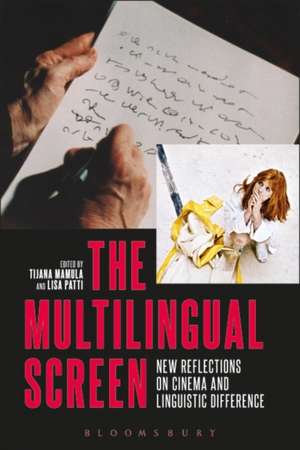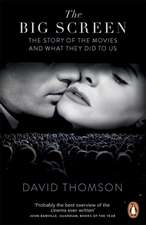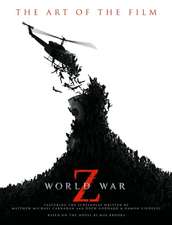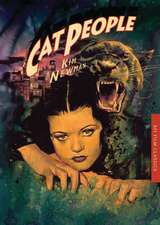The Multilingual Screen: New Reflections on Cinema and Linguistic Difference
Editat de Tijana Mamula, Lisa Pattien Limba Engleză Paperback – 29 iun 2016
| Toate formatele și edițiile | Preț | Express |
|---|---|---|
| Paperback (1) | 241.89 lei 6-8 săpt. | |
| Bloomsbury Publishing – 29 iun 2016 | 241.89 lei 6-8 săpt. | |
| Hardback (1) | 835.51 lei 6-8 săpt. | |
| Bloomsbury Publishing – 29 iun 2016 | 835.51 lei 6-8 săpt. |
Preț: 241.89 lei
Preț vechi: 275.79 lei
-12% Nou
Puncte Express: 363
Preț estimativ în valută:
46.28€ • 48.46$ • 38.30£
46.28€ • 48.46$ • 38.30£
Carte tipărită la comandă
Livrare economică 05-19 aprilie
Preluare comenzi: 021 569.72.76
Specificații
ISBN-13: 9781501302879
ISBN-10: 1501302876
Pagini: 384
Ilustrații: 25 bw illus
Dimensiuni: 152 x 229 x 30 mm
Greutate: 0.57 kg
Editura: Bloomsbury Publishing
Colecția Bloomsbury Academic
Locul publicării:New York, United States
ISBN-10: 1501302876
Pagini: 384
Ilustrații: 25 bw illus
Dimensiuni: 152 x 229 x 30 mm
Greutate: 0.57 kg
Editura: Bloomsbury Publishing
Colecția Bloomsbury Academic
Locul publicării:New York, United States
Caracteristici
Includes essays and interviews by practitioners, crucial for keeping in line with the developing practice of crossing boundaries between "theory" and "practice" in universities
Notă biografică
Tijana Mamula teaches film studies at John Cabot University in Rome, Italy. She is the author of Cinema and Language Loss: Displacement, Visuality and the Filmic Image (2013). Lisa Patti is an Assistant Professor in the Media and Society Program at Hobart and William Smith Colleges, USA. She is the co-author of Film Studies: A Global Introduction (2015).
Cuprins
Acknowledgements Introduction Tijana Mamula(John Cabot University, Rome, Italy) and Lisa Patti (Hobart and William Smith Colleges, USA) Part 1 Theories 1 Translating the Academe: Conceptualizing the Transnational in Film and Media Masha Salazkina (Concordia University, Canada) 2 Seven Types of Multilingualism: Or, Wim Wenders Enfilms Pina Bausch David Gramling (University of Arizona, USA) 3 Post-anthropocentric Multilingualism in Contemporary Artists' Moving Image: An Interview with T.J. Demos Tijana Mamula (John Cabot University, Rome, Italy) 4 Cinephilia as Multilingualism in The Artist (2011) and Blancanieves (2012) Mary Harrod (University of Warwick, UK) Part 2 Aesthetics 5 The Gift of Languages: Notes on Multilingualism in Experimental Cinema Érik Bullot (École nationale supérieure d'art and The European School of Visual Arts, France) 6 Exile and the "Languages" of Color: 1960s European Cinema, Multilingualism, and Ontological Hesitation Paul Coates (University of Western Ontario, Canada) 7 The Word in Pasolini's Cinema Gian Piero Brunetta (University of Padova, Italy) 8 West African Francophone Cinema and the Mysteries of Language: From Ideological Struggle to Aesthetic Shudder James S. Williams (Royal Holloway, University of London, UK) Part 3 Histories 9 Language in Motion: The Sign Talk Films of Hugh Lenox Scott and Richard Sanderville Brian Hochman (Georgetown University, USA) 10 Poorly Timed Campaigns: Versions, Dubbing, Subtitles Juan Piqueras (Film critic and theorist, Spain) 11 The Multilingual New Wave Alison Smith (University of Liverpool, UK) 12 Language and National Identity in New Tunisian Cinema: Moufida Tlatli's The Silences of the Palace (1994) and Férid Boughedir's A Summer in La Goulette (1996) Robert Lang (University of Hartford, USA) 13 Cinema of Reindividuation and Cultural Extraterritoriality: "Chinese" Dialect Cinemas and Regional Politics Victor Fan (King's College London, UK) Part 4 Politics 14 Empire, Language and Nationhood: Japanese Colonial Cinema in Korea and Manchuria Kate Taylor-Jones (Sheffield University, UK) 15 Star Talk: Anna May Wong's Scriptural Orientalism and Poly-phonic (Dis-)play Yiman Wang (University of California, Santa Cruz, USA) 16 Out of Many, One: The Dual Monolingualism of Contemporary Flemish CinemaJaap Verheul (New York University, USA) 17 Multilingualism and Indigenous Cinema in Northeast India: The Case of Kokborok Language Films Mara Matta (University of Rome "La Sapienza," Italy)18 Programming Latin American Cinema in the US: An Interview with Carlos A. Gutiérrez Lisa Patti (Hobart and William Smith Colleges, USA) Contributors Index
Recenzii
As earlier with sound, the study of linguistic difference in cinema is gradually emerging from the shadows of Anglophony and into film theory's spotlight. The Multilingual Screen will be among the volumes instrumental for this turn. Conceptually original, genuinely plurilingual in its reach and research, catholic in its methods, the volume maps not only the terrain of languages as such but, more surprisingly, the tectonic force of split-language-consciousness on cinematic forms.
Smart, comprehensive and geographically wide-ranging, The Multilingual Screen delves into the material conditions that give rise to cinema's many languages, including its own particular visual grammars and vocabularies. Transnational Film Studies has been waiting too long for a collection like this.
Smart, comprehensive and geographically wide-ranging, The Multilingual Screen delves into the material conditions that give rise to cinema's many languages, including its own particular visual grammars and vocabularies. Transnational Film Studies has been waiting too long for a collection like this.









